 |
Peace and Construction, or War and Destruction?
by Hussein Askary
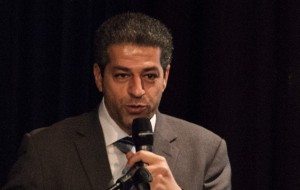 Hussein Askary.
|
Askary is EIR’s Arabic Editor and chairman of the Swedish European Labor Party. He gave this speech at the Schiller Institute’s April 13-14 “Forum for a New Paradigm” in Frankfurt, Germany. The video is at http://newparadigm.schillerinstitute.com/.
As many of you might remember, last November we were in this same place, and Helga Zepp-LaRouche presented an idea of how to deal with the danger of war in Southwest Asia, incluidng the terrible developments in Syria, and the barbaric attack, not only on the Syrian people, but on a whole culture, a whole civilization, from inside Syria. And also the threat of an attack on Iran. She presented a concept for how to find a common goal for all nations to work toward together, and I, with some of my colleagues, collaborated to elaborate what we could present as a solution, and also as a goal, to unite the nations of the region. And also to get international powers, who now otherwise will end up in conflict-the United States, the whole British Empire, in conflict with Russia, China-through a world war.
This was the original idea, and then we had a discussion about how we could deal with the extension of deserts, from Africa to Asia, which is a threat to societies. And also how to work, scientifically, politically, economically, to limit the effect of the desert, and eventually to green the deserts. That this would be a planetary program, where all nations can cooperate.
The details [1] of this, of course, were presented at the previous conference; I’m not going to go through them. I want just to show you what progress has been made.
Just be forewarned that this project cannot be implemented today, as it is. It’s impossible right now to finance any infrastructure project, industrial project, of this magnitude, or even any other magnitude, because of the present financial and economic system. So the first prerequisite will be to eliminate the current financial system by what Lyndon LaRouche said: solving the mystery of money, with Glass-Steagall. That is the first requirement.
The second point is that the nations of the region cannot stop these wars. There is nothing Syria can do, other than defending itself, to stop the war. Libya could not do anything to stop the invasion. Iraq could not do anything. Because there was an intention, there was a policy, to invade Iraq. There was a policy, which was not Saddam Hussein’s intention. And it was the same thing for Qaddafi. There is also an intention to attack Iran. Iran cannot do anything to stop an attack on Iran, or a war, other than trying to defend itself.
It reminds me of the story of a young man who was run over by a car, and his father went to the prison to meet the driver, and to ask why he did it. And the driver said, “Well, I tried to warn your kid; I honked at him; I sent a signal with a light; I waved at him, but he did not get out of the way.” So, the father went to the hospital and told his son, “The driver says he did all these things to get you out of the way.” And the boy said, “I know he did these things, but how could I get out of the way? I was sitting in a restaurant.”
So, these nations are sitting there. They can’t get out of the way.
We have been having discussions with government representatives in the region, with experts, with the organizations, to bring this idea into the forum of discussions where people try to talk about solving political problems. Because we cannot have peace without economic development, and that this should be included in every peace initiative. And also it’s very important that Russia, China, other nations, that discuss with the United States or Europe, any discussion about peace in Southwest Asia must include a perspective for improving the living conditions of the population.
I have a message that I’ll show after my presentation, from an Iraqi official [see next article]. We have been getting in contact with many officials and experts on water and desertification, and so on. As I said, we have to have a new economic order. We have to stop the war policy, as LaRouche and [LaRouche candidate for governor of New Jersey] Diane Sare said, by impeaching Obama; but we cannot wait for the future, like people wait for a bus to come and try to get on the bus. We have to build the bus; we have to prepare for the future.
Intervention in Iran
The first qualitative response we got from Helga’s and my presentations, which we continued as a campaign, was from the Iranian government. Helga and I were invited in March to a conference organized by the Iranian Foreign Ministry’s International Center for Political Studies, to present these ideas. The conference was about the security of the Persian Gulf after the Arab Spring and revolutions, and what implications that had.
Unfortunately, Helga could not attend the conference. I attended, but Helga’s paper was published with the conference proceedings. The problem at the conference was that all the discussions, which reflect the danger in the region, were about the threat of sectarian war, the geopolitics, and the Shi’a/Sunni divide, and all these horrible things that take place. People are living inside that hell right now, and of course, it’s difficult for them to see a solution other than trying to survive and maneuver within that situation.
|
FIGURE 1
World Land-bridge 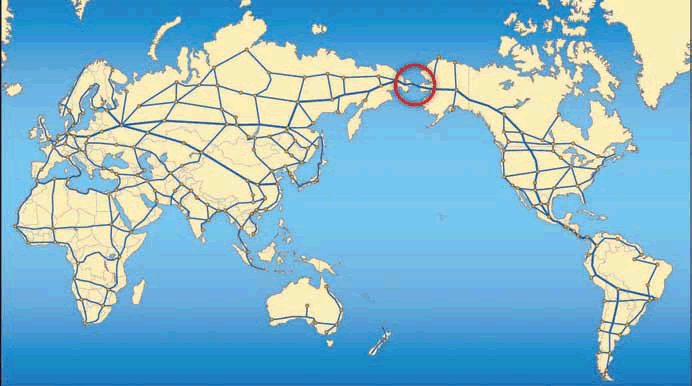 EIRNS
Rough outlines of the Schiller Institute’s proposals. The circle at the center designates the Bering Strait bridge/tunnel, which would connect Eurasia with the Americas.
|
But I had the chance to speak and present our idea. I actually started by bringing up the meterorite explosion over Chelyabinsk to the audience, to get their attention. But when I presented the perspective for greening the deserts and the Eurasian Land-Bridge (Figure 1) as the Schiller Institute’s Peace Plan, there was a change in their minds. Because if people are down there looking at the horrors of war, but then you bring them to a higher platform to see the world from a different viewpoint, then the mind opens up, and says, “Great! Why didn’t we think of that ourselves?”
This is the impact of getting out of the smaller issues, and getting to the global planetary aspect of this.
|
FIGURE 2
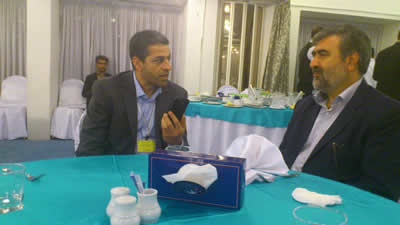 Hussein Askary, left; the governor of Hormozgan, right.
|
This conference was organized not in Tehran, the capital, but in Bandar Abbas. This is the governor of Hormozgan (Figure 2). We have an interview with him; it’s in the EIR,[2] and a report from the conference. Hormozgan is the province which controls the islands which lie in very important Hormuz Strait. There was a discussion yesterday about the flow of oil from there. The Gulf-people call it the Arab Gulf on the Arab side, the Iranians call it the Persian Gulf-but 40% of all oil exports from the Gulf to international markets go through the Hormuz Strait. Ninety percent goes to primarily China, Japan, Korea, and India. Japan increased its imports of oil as a way of diversifying there, because this was the easiest and quickest to get more energy, after Fukushima-to import more oil from the Gulf. So, they’re getting more dependent on that.
|
FIGURE 3
Strait of Hormuz  |
And it’s in that narrow area where all this is taking place (Figure 3). I visited these islands on the Iranian side. You can see that this is one of the most important and most sensitive areas in navigation and transport, in the world, but it also can become one of the most terrible places on Earth. When American aircraft carriers pass by there, people can see them from the Iranian side. Somebody was telling me that there might a hotline between the American and Iranian military, or an indirect hotline, to avoid an accident that could lead to a major outbreak of fire, and that could lead to an outbreak of war.
So, the Hormuz Strait is very, very important. And you have these three islands, Greater Tunb, Lesser Tunb, and Abu Musa-these are contested by Iran and the United Arab Emirates. The Emirates claim that these belong to them, and the Iranians have sovereignty there.
A British Game
This was a British game. In 1971, when the British left, they handed over the place-not handed over, but they left the Shah of Iran in control of these islands, and now the British are encouraging the United Arab Emirates to take it back! So, the Hormuz Strait has the potential of becoming a major breakout point for war.
Figure 4: Shaheed Rajaei container ship port complex near Bandar Abbas, Iran. |
Now, Hormozgan, the Iranian province, is one of the fastest growing provinces in Iran, because the Iranian government has built a railway which extends from Northern Iran to Bandar Abbas, and they built this port, Shaheed Rajaei, a container ship port, a very, very large port (Figure 4). And now, many nations in Central Asia are totally dependent on cargo and trade going from Bandar Abbas, coming from Asia and elsewhere, to the land-locked countries of Turkmenistan, Uzbekistan, Kazakstan. So this has become one of the most vital trade routes between the Indian Ocean region and Central Asia. We can call this the “Silk Road strategy.”
The Iranians, in spite of all the economic sanctions, threats and so on, have been very consistent in building infrastructure projects which have transcontinental significance.
| Figure 5 Regional railroads. |
In 1996, they built a small section to connect with the old Soviet railway system, and to China (Figure 5). China had simultaneously built a connection to Kazakstan, so the old Silk Road was rebuilt. And later, Iran built a connection to Turkey, where Europe and Asia were connected through this. And then there’s the North-South Corridor, which goes from Russia to India. There’s an agreement among Russia, Iran, and India to build a trade route through the Caucasus, through the Iranian railway network, and this is being built right now to Chah Bahar on the Arabian Sea.
India is very interested in this, because shipping by sea takes about three weeks to the Black Sea, while the railway system through Russia takes one week. So this is an enormous change.
The Iranian strategy has been to position itself in an economic way, in a peaceful economic way, to make other nations dependent on it for their trade and livelihood. This is a very good strategic defense method. They’re also bulding gas pipelines to Turkey, and they have just built a gas pipeline to Pakistan, which is very important to get Pakistan on board, to solve the problem in Afghanistan, and leave the Anglo-Saudi party, which is destabilizing Iran, by creating economic cooperation.
Most of the Iranian officials at the conference were actually speaking about getting an agreement in the Gulf, among all the Gulf countries, a peace agreement, based on economic cooperation. And also cultural cooperation.
So they all realize now that the way to get out of this is not religious agreement, is not strategic or political agreements, but economic dependency among nations.
The Economic Sanctions
Figure 6 Ships waiting near the Hormuz islands. |
I want to talk about the sanctions. I was going to one of the Hormuz islands by ferry, and there were many, many ships in the sea, just standing there (Figure 6). There was a man sitting next to me from Customs, and he said, these ships, they’re not there waiting for something. They’re just parked there because of the economic sanctions. And he said that along Iran’s 2,000-kilometer coast there are about 5,000 major ships standing still because of the economic sanctions. Because the Iranian Central Bank cannot have contact with international banks, and the ships cannot get letters of credit, they can’t get insurance. This is an enormous loss for Iran, but also an enormous loss for world trade.
The Iranians are hit hard by the sanctions. The Iranian currency has gone down 300% against the dollar. Capital is flying from the country. Young people are trying also to find ways to go out of the country to find jobs for the future. But despite that, the Iranians are trying, with the little resources they have, to do something for their country, with the hope that there will be peace, that their country will be able to continue its economic development.
Global Casino Economy
I just want to show you the insanity of the current economic system.
Figure 7 Dubai. |
On the other side of the Gulf, we have Dubai (Figure 7), the allies of the British; and besides being one of the largest drug-money-laundering centers in the world, it’s also the shopping capital of the world. But it’s a completely arid country. And this was not built by the rich Arabs. This was one of the biggest Ponzi schemes in modern history, because Dubai doesn’t have many resources-Abu Dhabi has the resources, the neighboring city. But in order to build these things, they were selling future projects to investors with brochures.
This is one of their ideas (Figure 8). Instead of greening the desert, they offer to build artificial islands in the sea, for tourists, nightclubs, shopping centers, and so on and so forth. You have all these fancy things, by dredging the sand and building artificial islands. (Actually the environmentalist movement said nothing about this, although they are burying all the corals.)
Figure 8: The Dubai islands.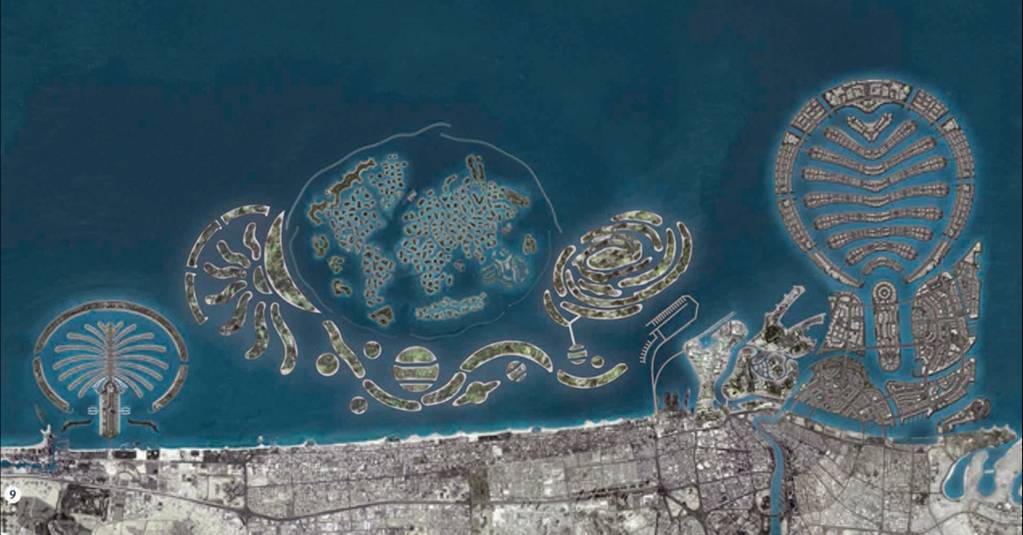 |
||
 |
 |
|
Figure 9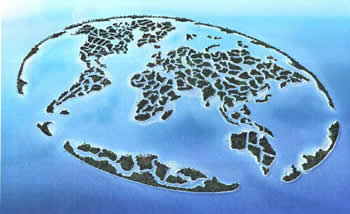 |
Figure 10 |
|
This is, for example (Figure 9), one of the projects they tried to sell in 2006. You have artificial islands, and you can buy a country, and build whatever you want on that country! Seventy percent of it was sold to international so-called developers, billionaires and so on, but this is what the brochure looked like. But the company in Dubai, with the economic crisis hitting it big, was not able to finance it anymore, and the real estate prices in Dubai collapsed in 2008, and they were not able to get any new money for the future projects to finance the current projects.
So, this is how it ended up (Figure 10). It’s sinking in the sea! There are only two islands which are built, and there are more lawyers who are working to solve this than engineers. Because all the people who bought the islands-they can’t do anything. There’s no infrastructure. And it’s also destroying the waters of the Gulf.
|
FIGURE 11
Sovereign Wealth Funds 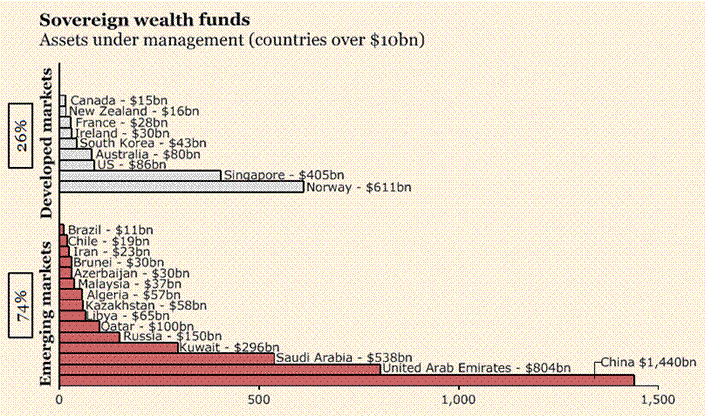 |
So, one more thing that we have in the Gulf, which is connected directly to the international financial system, is the so-called sovereign wealth funds (Figure 11). The Arab sovereign wealth funds, jointly, make up about $2 trillion. And this makes a lot of big bankers and financiers in the City of London and Wall Street drool over it. China is the largest one in the world, but the Chinese are using their capital in a wise way. They’re not included in this.
|
FIGURE 12
Sovereign Wealth Fund Transactions  |
But the Arab countries were lured into supporting the financial bubble, and also the bailout bubble (Figure 12). This is a list of the transactions that were made by these sovereign funds between 2007 and 2008. Like the Kuwait Investment Authority: They bought shares in Citigroup; 2012, a billion dollars in Citigroup also; Abu Dhabi, $7 billion; Merrill Lynch-Kuwait, $6 billion, and so on and so forth. But the oil money and all these things are going. I mentioned this to our friends from Norway, and the Norwegians have the same situation with their oil fund.
FIGURE 13  View full size |
And this is called the new Global Wealth Machine (Figure 13). The diagram shows you where the money comes from, and where it ends up. And it’s all British and Wall Street banks. And then to the left, you have the advisors: You have Lazard, you have all kinds of so-called advisory groups; and you have the lawyers on the right. These are the people who are advising the Arab Gulf states on financial affairs, and where to invest their money. And it’s completely British-controlled, by the City of London or Wall Street.
|
FIGURE 14: Investments in Dubai
 |
And this is where the money went (Figure 14): financial transactions-$160 billion since 2008; real estate-$60 billion; infrastructure and utilities. And this is not building new infrastructure and utilities-like Dubai Ports Company, they buy ports that are already built in Europe, or in the United States. (They couldn’t buy one in the United States, because people in Congress were talking about national security.) And at the bottom of the list, you have investments in health care. This is where all the investments are going.
| FIGURE 15 Who advises investors in Dubai |
And the people who are advising them: This (Figure 15) is from the London School of Economics, Mark Thatcher. But this is not the infamous son of Margaret Thatcher, the arms dealer. This is another infamous Mark Thatcher who works in the London School of Economics.
And it’s an interesting study, because it says that the United Kingdom gets the most investments from the Arab countries, because they follow free trade. The United States gets very little Arab money because it is more cautious about national security and allowing the Arabs to come into its system. But in spite of that, they did pay.
So, this is how the show is run on the Arab side.
Potential for Development
But this is not the end of the road. Most of the money is gone, but to hell with the money. We have nations in these regions. In Dubai, you still have one of the world’s largest airports. You have the largest port. In Abu Dhabi, they’re building four nuclear power plants, with the help of South Korea. So, you still have potential for development. And it’s not that we are not talking to them; we are trying to talk to these governments on this side of the Gulf, but it’s difficult to have a dialogue with Saudi Arabia, for example, when the national security chief is Prince Bandar bin Sultan! They will not allow anybody to talk to us.
Figure 16 Mr. Lyndon LaRouche in Abu Dhabi in 2002. |
This is Mr. Lyndon LaRouche in Abu Dhabi in 2002 (Figure 16). This was a very big conference on the future of oil and the international economy. The Oil Minister of the United Arab Emirates is there, and Mr. LaRouche was treated as a guest of honor. And actually, the United States, Britain, New Zealand, Canada, and Australia-all the ambassadors-sent letters to the Zayed Centre asking them to disinvite Mr. LaRouche, that he should not come to attend this conference. They even got threats. But they didn’t care about that; there were some interesting people there at the time.
Mr. LaRouche issued a very strong warning[3] to the people-and there were people from Saudi Arabia, from all the Gulf countries, very important people-a very strong warning about the coming financial collapse. That was in 2002. And he said that we should get to the lifeboats! (I remember LaRouche said that, because I translated the speech.)
But he also, in a very friendly way, advised them on how to invest in their economy by focusing on nuclear power, focusing on petrochemicals instead of selling oil as a raw material, focusing on greening the desert, water desalination, and building a real industrial economic base.
Of course, they lost these years, and the whole region has lost these years, as Japan lost ten years, as Europe is losing time. We have been losing time; but the issue is, that we still can go back there and have a totally new policy. But we have to have a new world economic order, based on the principles that we discussed here, the Glass-Steagall, and stopping the war policy.
When I was in Bandar Abbas-because if you stand somewhere new, you see things from a different viewpoint-in this region, from Iran to Turkey to Iraq, Syria, the Gulf States, Egypt, Ethiopia, Somalia, and Sudan, you have about 400 million people, and these are potentially, very, very rich countries. The population is very young, and actually in many of these countries, people are very well educated, but the current policy is killing this region, and also killing the possibility for other nations to invest, or to have this as a market for both capital goods and consumer goods.
As I said, 90% of the oil in the Gulf goes to Asia. But in return, 80% of all imports-capital goods and consumer goods-also come from Asia. So Asia is dependent to a large extent on trade with this region. But imagine, if you develop this region in the correct way, which we have proposed-to have 400 million people with great resources, and also in a very strategic position between three continents, you could create an economic miracle in that region.
‘People Want To Live’
And also, when you talk to people there, and you see the children, you see that people love life there. They love beauty. I was standing in Bandar Abbas on a huge boulevard, and the people around, they love to have picnics, but usually they have picnics in the evening because it is hot there. And you see all these kids playing, you look at the Strait of Hormuz, the water, and you imagine that there may be an aircraft carrier there the next day. And totally horrendous thoughts came to my mind. But people there want to live, they want to have a future.
On the flight from Tehran to Bandar Abbas, there was a young Iranian man, 24-25 years old, sitting next to me. And he was studying a huge map of an electric device or machine. It seemed that he was going there to work. And then before we landed, he put it away and quickly took out a notebook, and started writing things in Persian. I’m not good in Persian-I can manage, but-. He was looking out the window, and then he was writing something and smiling.
And then, from the shape of the lines, I realized that he was writing a poem. He was smiling and looking through the window, and then writing things. It really moved me to see those young people-and this is where the issue of culture is coming in here. Because it’s not material things we are talking about. We are talking about uplifting the human soul. And I think the ingredients are there, both in Iran and Iraq, in the Arab world. We do have the Renaissance, for which we are grateful to the Greeks and Plato.
But we have the ingredients for progress, for a cultural renaissance in the region. But the problem is that we don’t have a just world economic order, and I think this is the challenge which is presented today, and we have to all work to that end.
[1] http://www.schiller-institut.de/konferenz-november-2012/askary.html
[2] See “Report from Bandar Abbas, Iran: EIR Attends 21st Persian International Conference on the Persian Gulf”
[3] See EIR, June 14, 2002. (http://www.larouchepub.com/pr_lar/2002/020602_zayed_speech.html.)

 View full size
View full size 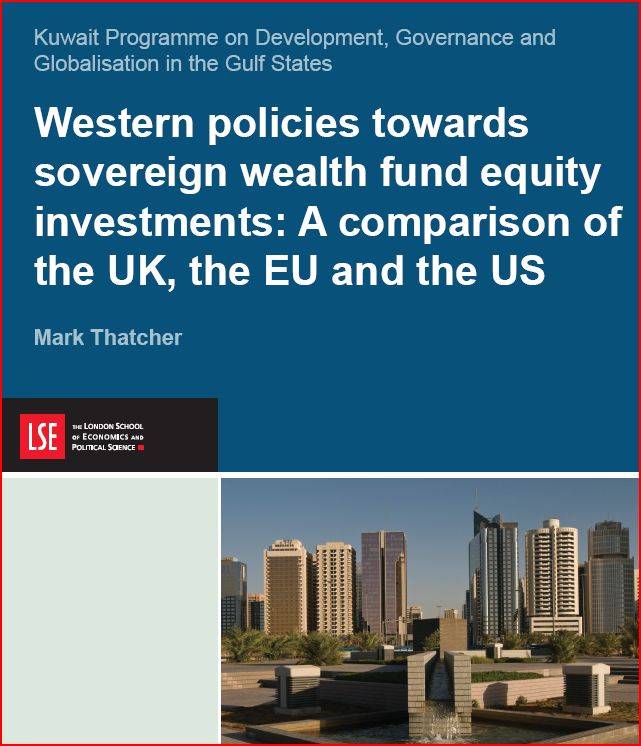 View full size
View full size